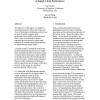Free Online Productivity Tools
i2Speak
i2Symbol
i2OCR
iTex2Img
iWeb2Print
iWeb2Shot
i2Type
iPdf2Split
iPdf2Merge
i2Bopomofo
i2Arabic
i2Style
i2Image
i2PDF
iLatex2Rtf
Sci2ools
114
Voted
HICSS
2007
IEEE
2007
IEEE
The Impact of Information Technology on the Temporal Optimization of Supply Chain Performance
The objective of this paper is to suggest a systematic means by which the timing and focus of information technology policies can be used to optimize supply chain performance and reduce production times. This is done by extending an earlier statistical physics model for quasi-static situations to examine temporal phenomena in manufacturing supply chains. A simple model is considered in which the product manufacturing process in a supply chain resembles the flow of a fluid in a pipe. At each position in the pipe, value is added to the fluid to produce the finished product at the exit orifice. Following the statistical physics model, information technology policy impacts the rate of change of the flow velocity by the action of a statistical physics-derived effective force. It is found that wave phenomena naturally occur in the inventories in supply chains. A simple quasilinear analysis of the phenomena shows that information technology policy can be used to adjust timing and position is...
Biometrics | HICSS 2007 | Information Technology | Statistical Physics Model | Supply Chains | System Sciences |
Related Content
| Added | 02 Jun 2010 |
| Updated | 02 Jun 2010 |
| Type | Conference |
| Year | 2007 |
| Where | HICSS |
| Authors | Ken Dozier, David Chang |
Comments (0)

